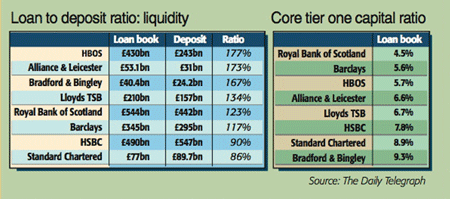How safe are British banks?
The virtual collapse of US bank Bear Stearns sent waves of panic over the Atlantic. Are the worries justified? Tim Bennett reports.
The virtual collapse of US bank Bear Stearns sent waves of panic over the Atlantic. Are the worries justified? Tim Bennett reports
What's going on?
The virtual collapse of Bear Stearns, America's fifth-biggest investment bank, sent waves of panic across the Atlantic. Monday saw the Bank of England deluged with requests from UK banks for five times the £5bn of emergency loans it made available. Investors in turn furiously sold off UK and European banks, compounding big falls since last summer.
Are UK investors overreacting?
No. As the FT's Lex points out, UK bank share price drops since last summer have not been indiscriminate or unwarranted; there is "method to the selling". Three things are currently spooking investors. First, there is deep-seated fear about asset quality and the possible extent of further subprime write-downs. Then there is the added concern about UK banks, which, like Northern Rock, depend too heavily on rapidly dwindling "wholesale" funding from the frozen inter-bank money markets, rather than deposits from retail savers. And finally there are concerns that, despite recent dividend hikes, some banks will nevertheless have to raise extra capital if the credit market woes continue.
MoneyWeek
Subscribe to MoneyWeek today and get your first six magazine issues absolutely FREE

Sign up to Money Morning
Don't miss the latest investment and personal finances news, market analysis, plus money-saving tips with our free twice-daily newsletter
Don't miss the latest investment and personal finances news, market analysis, plus money-saving tips with our free twice-daily newsletter
Is American subprime debt a problem here?
So far the UK's biggest banks have avoided the huge hits taken by their US rivals Citigroup has written off around £10bn and Merrill Lynch £7bn, for example, whereas the worst culprits here RBS and Barclays have written off less than £4bn between them. But the headache for investors is working out where the remaining toxic mortgage-related assets are hidden. According to Christine Seib in The Times, Barclays and HBOS carry the highest exposure to the gruesome duo of US subprime and Alt-A loans (where borrowers often self-certify their income) at £14.5bn and £13.7bn of assets respectively. This, says Philip Aldrick in The Daily Telegraph, equates to a staggering 80% and 66% of their tangible equity, with other banks also carrying sizeable exposures as the table below shows. With America quite probably in recession and its housing market still in freefall, all such assets remain highly vulnerable to write-downs.
But weren't Northern Rock's problems unique?
The frenzy to secure funds from the Bank of England on Monday shows just how scarce credit has become. Northern Rock failed because just before the wholesale lending market snapped shut it was carrying an absurdly skewed loan-to-deposit ratio of 345%. So, for every £1 deposited by a retail saver, the bank was lending out around £3.50 and filling the gap by borrowing short term from other banks. But extreme as that model was, dependence on wholesale funding is nonetheless widespread, as the second table below shows. In normal markets this is fine. But should the crisis "widen and deepen", as The Independent's Jeremy Warner expects, a funding crisis could engulf another smaller player.
Could a British bank go bust?
In theory, no; capital adequacy rules enforced by the Financial Services Authority should ensure that a bank has a "tier 1" buffer of at least 4% of what it lends out (adjusted for risk) in ultra-safe instruments, such as cash and government bonds. However, this 4% was 8% until fairly recently (before the "Basle II" accord came into effect), so the safety net has shrunk. Also, as the table below reveals, some banks are flirting dangerously with breaching the current target.
% of tangible equity in toxic debt
Barclays 80%
HBoS 66%
Bradford & Bingley 36%
Royal Bank of Scotland 29%
Lloyds TSB 25%
Alliance & Leicester 18%
Standard Chartered 10%
HSBC 7%

Are there any other warning signs?
Asset quality, liquidity and funding concerns are all summed up by the market for credit default swaps, whose prices capture the cost financial institutions charge each other for insuring against a particular bank going bust. In short, the higher the price (captured as a percentage gap, or "spread", above safe government bonds), the greater the perceived risk of default.
Among the UK banks perceived to be riskiest under this measure are HBOS (2.8%), RBS (2.03%) and Barclays (1.74%) although other global banks, such as those in Iceland and Ireland, are deemed even more vulnerable by this measure. Worryingly, spreads across the board have been rising since last August. In short, Bear Stearns is "unlikely to be the end of the workout", as Warner puts it.
Get the latest financial news, insights and expert analysis from our award-winning MoneyWeek team, to help you understand what really matters when it comes to your finances.
Tim graduated with a history degree from Cambridge University in 1989 and, after a year of travelling, joined the financial services firm Ernst and Young in 1990, qualifying as a chartered accountant in 1994.
He then moved into financial markets training, designing and running a variety of courses at graduate level and beyond for a range of organisations including the Securities and Investment Institute and UBS. He joined MoneyWeek in 2007.
-
 Investors will reap long-term rewards from UK equities
Investors will reap long-term rewards from UK equitiesOpinion Nick Train, portfolio manager, Finsbury Growth & Income Trust, highlights three UK equities where he’d put his money
-
 The graphene revolution is progressing slowly but surely
The graphene revolution is progressing slowly but surelyEnthusiasts thought the discovery that graphene, a form of carbon, could be extracted from graphite would change the world. They might've been early, not wrong.